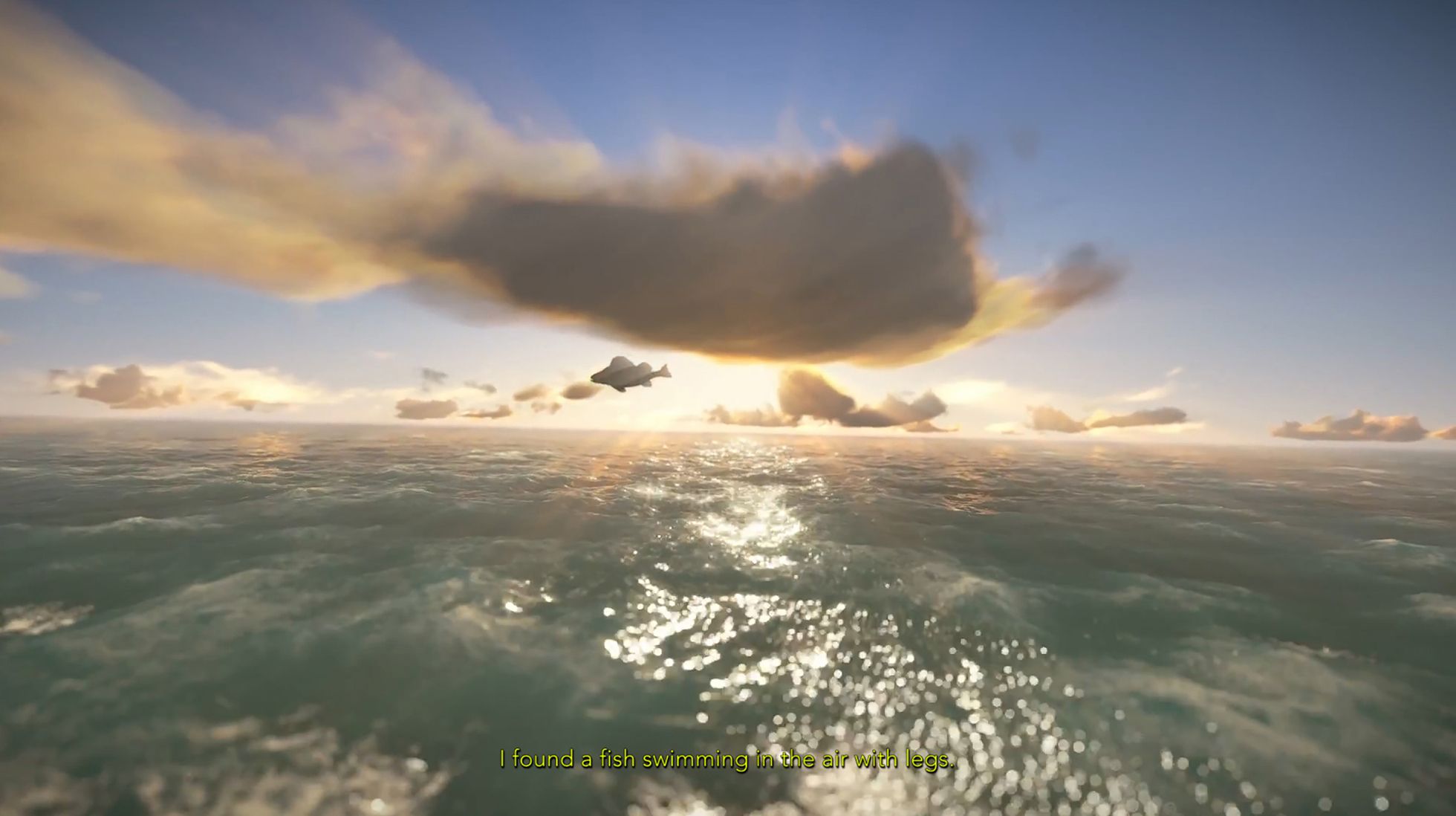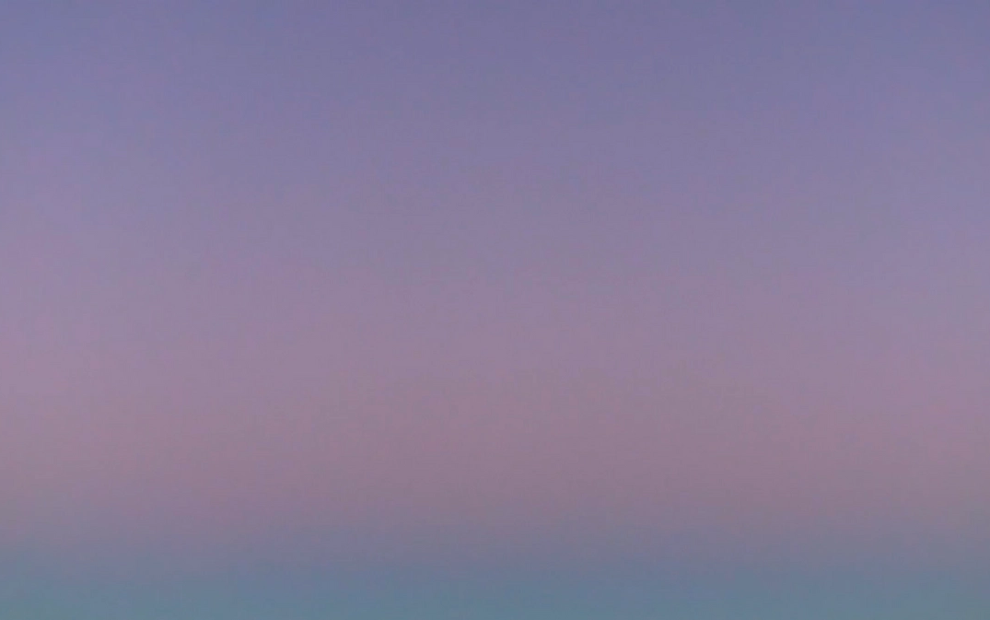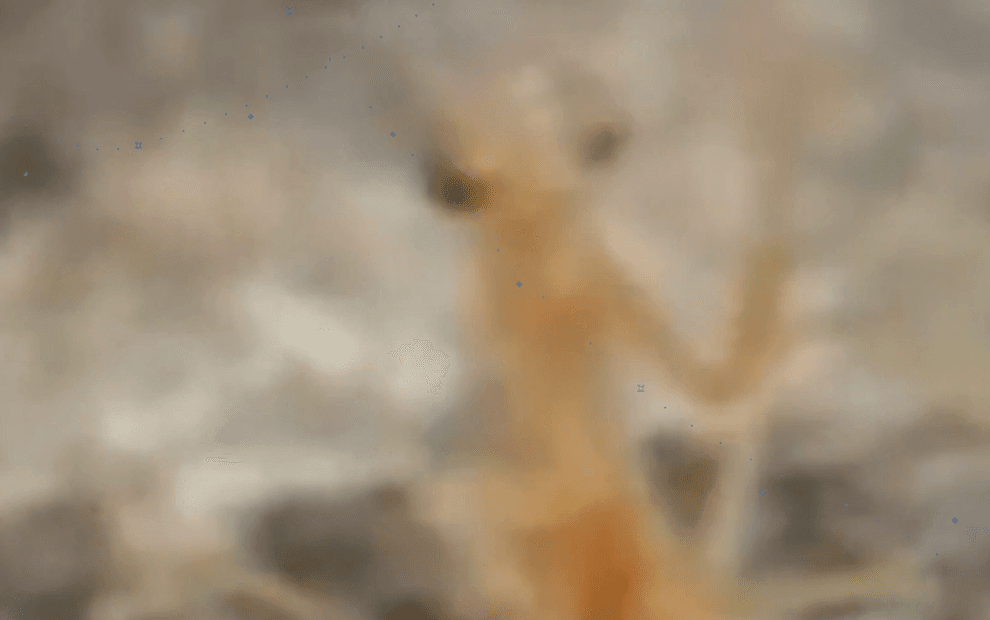Under a Different Sky
Electronic Disturbance Theater 2.0/b.a.n.g. lab (EDT), Mohamed Chamas, Diogo Evangelista, Tzu Huan Lin
1 May–31 Jul 2021
Under a Different Sky, 2021, HD video with sound, 29:20min.
Directed by Lucie McIntosh and Jake Treacy, this production features video works by Diogo Evangelista (PTG), Tzu-Huan Lin (TWN/USA) and the Electronic Disturbance Theatre (EDT) 2.0/b.a.n.g Lab (USA), and is set to the dystopian cadence by Mohamed Chamas (AUS), and is told in three scenes. Courtesy the artists.
Diogo Evangelista, The Sky Exists (still from moving image), 2017, HD video with sound, 5’:09”.
Tzu-Huan Lin, Online Funeral Service I- TAMARA (still from moving image), 2015, HD video with sound, 10’:01”.
Electronic Disturbance Theater 2.0/b.a.n.g. lab, Transborder Immigrant Tool, 2007 – ongoing
Self-Annihilation (or Three Scenes from Spaceship Earth)
Even the run-down nature of the high-rise was a model of the world into which the future was carrying them, a landscape beyond technology where everything was either derelict or, more ambiguously, recombined in unexpected but more meaningful ways. Laing pondered this — sometimes he found it difficult not to believe that they were living in a future that had already taken place, and was now exhausted.
J G Ballard - High Rise
Grappling with tensions between notions of the ‘revolutionary subject’ and ‘total annihilation’ Under a Different Sky looks towards contemporary visions of dystopia, spotlighting anxieties such as survival, existence and (post) human identity. The drawing of doomsday has always been popular in the human imaginary — predictions of the great flood, the Last Judgement, the 2012 phenomenon and even the Q anon conspiracy all work to locate the looming danger in the world within a definite and perceptible source. Although this human obsession with fear, powerlessness and fantasy has its origins in ancient times — foretold throughout creation myths and retold until today — it has largely possessed the contemporary psyche and global culture as a hauntology of 19th and 20th century governmental propaganda and false-truths — namely capitalism. As cited above, Ballard observed the birth of these fictitious dystopian conventions into the ‘real’ world throughout the 20th century. Science fiction to science (non) fiction. From the internet in William Gibsons ‘Neuromancer’ to mass surveillance equipment in George Orwells ‘1984’, the spooky present-future we find ourselves in is ever near and is increasingly exhausted. The apocalypse seems to have already arrived.
Kandinsky famously said that the artist must be the priest of beauty. Throughout the last decade we have seen an abundance of art and theory professing to reimagine/reinvent/reshape future worlds, encoding countless utopias into the matrix through which we might also plug into. Yet amidst all of this rethinking the aesthetics of hope, resistance and imagination have been co-opted and repackaged for us to devour (or not to) – goaded on by the aesthetic economy. In a world in which it appears as if the left has failed, the plague has come, Bolsenaro and Trump look mild in an increasingly fascist political economy, and nothing (or at least not enough) is getting better, what is the point of painting an implausible Pollyanna picture of our future? While the global culture machine regularly claims to address power structures and foster a space for radical action, contemporary art’s position within networks of capital perpetuates the status quo at best, and at worst gaslights us into believing any number of false truths, false worlds, false futures. It is hard to not feel as we are trapped inside some Faustian allegory, exchanging our soles for something in the short term. Are we (artists) what Stephen Pitchard called ‘the gentrifying foot soldiers of capitalism’ - simply creating propaganda akin to the doomsday prophecy, distracting society from the larger, more sinister hyper-objects that are looming upon us? We know who the institution really plays for and it isn't us. Maya Angelou observed this act of camouflage in a conversation with Bill Moyers in 1982: “Throughout our nervous history, we have constructed pyramidic towers of evil, ofttimes in the name of good.” The timelessness of this statement feels profound yet also somewhat futile. Perhaps there is no light at the end of the wormhole.
The works included in this project (individually and together) speak to the futility of this meta-reflection, recognising that the cultural economy is but one cog in the suffocating bureaucracy of global power. Under a Different Sky postulates video as a dark mirror through which we may encounter scenes from the apocalypse—again. Directed by Lucie McIntosh and Jake Treacy, this production features video works by Diogo Evangelista, Tsu-Huan Lin and the Electronic Disturbance Theatre (EDT) 2.0/b.a.n.g Lab, and is presented through BLINDSIDE’s Satellite program. Under a Different Sky is set to the dystopian cadence by Mohamed Chamas, and is told in three scenes.
Scene 1: A Long Walk into Tomorrow
Opening scene: We travel into a snake-filled desert. Many have perished on this journey. This is a tradition of migration, a tradition of long walks. The sun is scorching, burning not only flesh, but also thoughts. Memory, however, is a sequence these days. 01100110 01110101 01100011 01101011 00100000 01110100 01110010 01110101 01101101 01110000. This is a journey of disturbance. Of survival. Of life itself. This is the US-Mexican border. We are guided by The Transborder Immigrant Tool, a hacked cell phone designed by the Electronic Disturbance Theater (EDT) 2.0/b.a.n.g Lab—a performance art-cum-activist organisation working out of the California Institute for Telecommunications and Information Technology at the University of California, San Diego. Taking a cheap and readily available cell phone, equipped with a built-in GPS applet, members of the organization co-opted the program and rewrote its code to establish a basic compass-like navigation system capable of directing users to water left by volunteer groups and medical help centres. Notions of citizenship, movement, and political control are disrupted through radical, open-source technology. The channels are low frequency and filled with static. Is this a cry for help, or poetry: Neither grey nor gray nor black and white. Ergo, un arcoíris. A bridge called my back. A wall, rotated 90 degrees.
Scene 2: Lost in the Galaxy of Mentality
The following questions are asked to the scene: What is the meaning of life? What is the life of meaning? What is machine consciousness? Where is the meaning in death?
The scene begins with an abstract story. The narrator serves as a medium traveling through imaginary cities, telling the inside to the outside, life to death, and narrative to non-narrative. Who is telling the story? A traveller, a bard, a king, or a soul being trapped on the internet? As the story goes on, the truth will be revealed. In Online-funeral service I-TAMARA,the artist, Tzu-Huan Lin, manipulates found footages and re-presents them with new meaning, cinematically provoking the next cut—a digital reincarnation. He explores the culture of mass reproduction by providing ‘new life’ to these found footages (otherwise ‘dead souls’). Through machine consciousness, he explores the construction of the social present whilst simultaneously blurring the ambiguous zones between opposing binaries - present/future, reality/fantasy, living/dead. His online funeral service becomes the real agent to channel these dead souls (footages) into the online world again. His work questions the conditions of digital identity, intersubjectivity and posthuman (or post-biological) consciousness. As he says, “Online funeral service is also a way to dedicate your loved ones and keep them alive and trap them in a fixed form eternally.”
Scene 3: Self-Annihilation
Final Scene: A cinematic score is the doomsday alarm clock to wake the sun. As it rises, so does the anxiety of the day. The Scene becomes brighter, hotter, and more depraved, eventually glowing with a radiation akin to a thousand atom bombs. This gesture is to prove that The Sky Exists. This work by Diogo Evangelista transmits the sun into a perpetual loop, and thusly broadcasts a human anxiety - our star—our life-source—immolating and emanating. Invaded by technical interferences, such as glitches and static, as well as live-streamed information typically found on a news broadcast, the video suggests an unstable condition. It constitutes a fictional recreation of false news gone viral. It was reported that, due to the high level of pollution, the sunrise would be video-transmitted live in Beijing’s Tiananmen Square. The Scene scrolls more news: “Everyone should avoid physical activity outdoors; Do not use your vacuum cleaner. Call your doctor if your symptoms worsen.” The Scene feigns an extreme meteorological condition that points to a pre-apocalyptic planet, alerting us to current ecological issues.
Often at the close of science fiction, the nuclear family survives, rising to greet the dawn of a new future however Evangelista’s narrative suggests a dystopian reality where everything seems to fail and the population has lost track of their essential references.
Score
The accompanying score has been commissioned by Naarm-based, artist Mohamed Chamas and makes audible the ambience/dissonance of a simultaneously ruined and sacred apocalypse. In these culminative soundscapes, Chamas employs a conscious occultation of digital prowess by deliberate use of rudimentary audio software. In surrender of technical skill, there is a reliance on encultured, mystic epistemologies (namely Sufi and Shi’a mysticisms), that act as luminary in approaching sound composition. Echoes of these aural pre-becomings sound in the intermediary realms (namely the Islamic “Barzakh”). Called into question are politicised and relative identities supposedly possessed with the trickster “djinn” (genies). These bodies aggravate and threaten sovereign powers, and so become augmented in an apocalypse. Their songs are distorted by colonial and phallogocentric apparatus. Chamas’ score finds an immutably grey oscillation; an etheric and electric swansong for non-essentialized selves.
-
We often find ourselves caught between the eternal struggle for a better world and the crushing weight of apathy that an age of hyper individualisation has brought upon us. We wonder where this leaves us. In his recent essay on the Insurgency of Life, Brian Kuan Wood reflects on Derrida’s writing on the sacredness of human life, noting that it “opens a space beyond the living that is also a space of death”. We think there might be something in this. Just as life is the imminent force the consumes and surpasses us, perhaps we humans are the only ones agonised by absence and mortality. Using science fiction and notions of cinema as obvious platforms to explore these timeless themes, our project explores the conditions of visuality and contemporary art under the Anthropocene, positing a critical reflection on the demise of utopian ideals through a number of inferences and references. If these dreams are designed to lead us towards some meaningful end perhaps the most radical position one can take now is a will to nothingness.
Blindside Satellite programs are presented online and onsite at the gallery as on public screens at Bunjil Place, Narre Warren; Harmony Square, Dandenong; Liverpool, Sydney and Beenleigh, Queensland.
The project examines notions of public space, specifically the public square and what it means for art to occupy these spaces and connect physically disparate audiences through a collective experience.
This program takes place on the land of the Wurundjeri people of the Kulin Nation. We recognise that sovereignty was never ceded - this land is stolen land. We pay respects to Wurundjeri Elders, past, present and emerging, to the Elders from other communities and to any other Aboriginal or Torres Strait Islanders who might encounter or participate in the program.
Electronic Disturbance Theater 2.0/b.a.n.g. lab (EDT)Electronic Disturbance Theater (EDT) 2.0 is a collective of artivists, performance artists, critical theorists, poets, and coders who engage in disturbances between digital and non-digital spaces. EDT 1.0, whose members included Ricardo Dominguez, Carmin Karasic, Brett Stalbaum, and Stefan Wray, developed the first virtual-sit-in technology in 1998 in solidarity with the Zapatista communities in Chiapas, Mexico. EDT 2.0, whose members include micha cárdenas, Amy Sara Carroll, Ricardo Dominguez, Elle Mehrmand, and Brett Stalbaum, was re/established in 2007. EDT 2.0 created the Transborder Immigrant Tool (TBT), https://tbt.tome.press, a GPS (Geo-Poetic System) cellphone safety net for wanderers on the Mexico–U.S. border.The Transborder Immigrant Tool has been presented at a number of U.S. and international venues, including ZKM, Center for Art and Media, Karlsruhe, Germany (2013); Van Abbemuseum, Eindhoven, the Netherlands (2013); Toronto Free Gallery, Canada (2011); California Biennial, Orange County Museum of Art (2010), Art in the Age of Anxiety, Sharjah Art Foundation (2020), and La vida nueva, Whitney ISP (2020). EDT 2.0 received the Transnational Communities Award, an award funded by Cultural Contact, Endowment for Culture Mexico–U.S. (2008). Additional funding for the project has been provided by CALIT2 (California Information Technology 2) and the Center for the Humanities at the University of California, San Diego.
Mohamed Chamas is an artist, game developer and poet based in Naarm (melbourne) who channels the 'dijital djinni'; a rewired/rewiring agent for practice-based research. Chamas' work calls upon magick and mysticisms of the ancient past to create fusion and synergy with emerging technologies. This diffractively interfaces with religious studies, ludology, performance, language, and critical and contemporary theory. Chamas' Virtual Reality (VR) works exist as unsurveilled sites of healing for orientalized bodies; namely سايبر تصوف (cyber tasawwuf) 2018 and باب القرين (Baab Al Qareen) 2020. The former received two Freeplay Independent Games Festival Nominations in 2019 and has exhibited at Testing Grounds, Seventh Gallery, Siteworks and Incinerator Gallery.
Diogo Evangelista’s work revolves around themes of desire, transformation, exploring the animist potential that the human imagination has to appropriate concepts, images and environment. Is work, in its multiple forms – sculpture, drawing, painting, and video – explores the interstitial zones between art, science, realism, fiction, technology and nature. Evangelista has had solo exhibitions at CAC (Vilnius), Cripta 747 (Turin), Galeria Zé dos Bois (Lisbon), Escola das Artes (Oporto), National Museum of Contemporary Art (Lisbon), A Certain Lack of coherence (Oporto), Galeria Francisco Fino (Lisbon), among others. His work has been presented in group exhibitons at the venues such as : Serralves Museum (Porto), MAAT (Lisbon), CIAGJ (Guimarães), DRAF (London), MOMMA ( Moscow), 11th Biennale Gwangju, Futura (Prague), Berardo Collection Museum (Lisbon) The Green Parrot (Barcelona), Caja Madrid (Barcelona).
Tzu Huan Lin is a practicing artist and working primarily on moving image media, including short video, feature film and animation. His work adapts to connect different stories to address the subject that he experiences in the digital era. Drawing on a wide variety of sources, including mythology, historical events, science theory, pseudo-documentary, and abstract narrative works. Narration plays an important core in his video that guided the journey through his work.
Lucie McIntosh is an artist, curator and writer with a deep commitment to the independent arts community. She is currently a Director and Program Curator of Blindside, an independent, artist–run space based in the City of Melbourne. Lucie’s exhibition and research based practice explores process of signification and, more specifically, in how the process of signification might be made visible through the content of an artwork. Her practice emphasises the inherently plural and personal nature of meaning—reminding us of, and celebrating, our agency in its creation. Lucie is interested in the many ways that ‘the image’ can be expanded and consumed in political and philosophical contexts. Her practice relies on plurality and intertextuality—each artwork compulsively referencing its many varieties of self, content, history and maker.
Jake Treacy is a curator, writer and poet whose practice employs numinous acts through exhibition-making, performativity, and the spoken and written word. They acknowledge that sovereignty was never ceded upon the Kulin Nations land from which they work, and pay their respects to Elders past, present and future across all First Nations. They are a University of Melbourne graduate with a Master of Art Curatorship (2017) and Postgraduate Art History (2013) who has previously co-directed an artist-run initiative, sat on grant advisory panels, and written published copy on numerous contemporary arts practices. Their recent thesis examines ways of constructing liminal experiences in order to incur healing, promoting inclusivity and community, and exercising the therapy of art. Their recent projects include Pearlescent Verse (Human Rights Arts and Film Festival), Apocalyptic Horse (Heide Museum), Utopian Tongues (Seventh Gallery), and Beyond the Veil (Blindside Gallery).
Related


